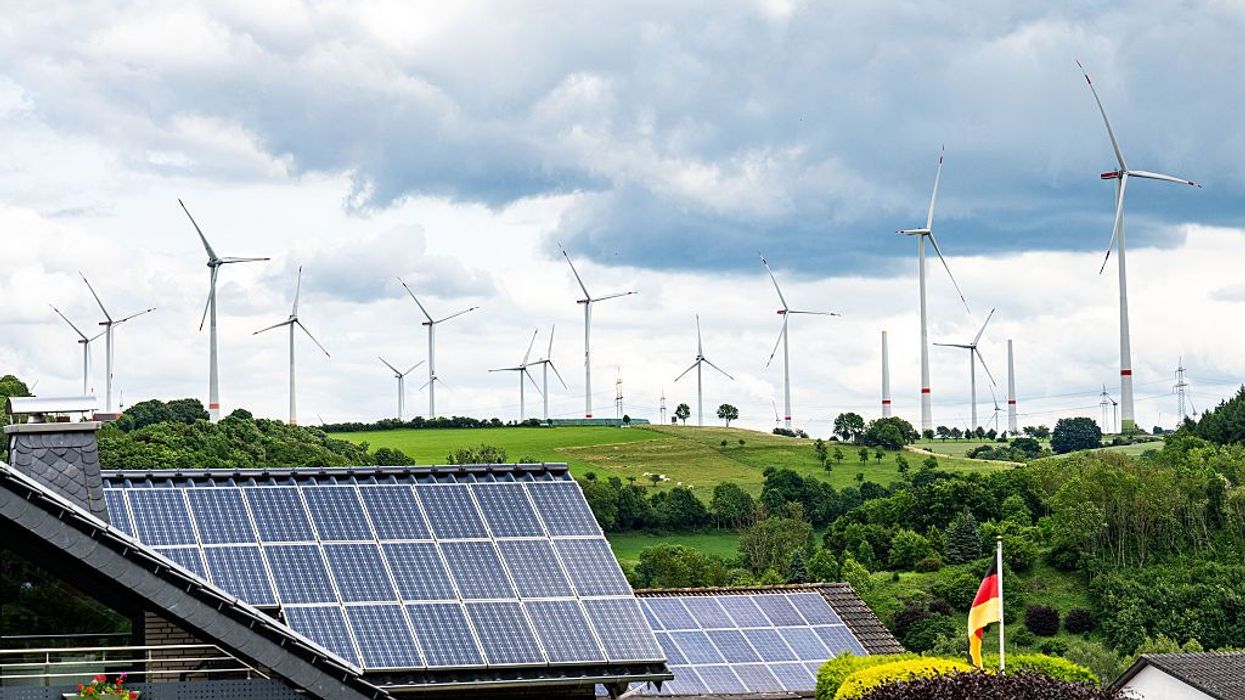September, 25 2008, 08:00am EDT

For Immediate Release
Contact:
Jenny Powers, 212/727-4566 and Kate Slusark, 212/727-4592
Landmark U.S. Global Warming Plan for Power Plants Launches
First-of-its-Kind Effort to Reduce Pollution Offers Northeast Head-Start Toward Clean Energy Economy
NEW YORK
In a landmark move to build a clean energy economy and cut global warming pollution, Northeastern states today kicked off the world's first emissions trading market that will promote efficiency and cut pollution from power plants. The new approach will reduce carbon dioxide pollution to a level 10 percent below current emissions by 2019, while rewarding smart companies that outperform new pollution limits and lowering energy costs for consumers.
"Today is a bold step forward for our clean energy future and the fight against global warming. The new system is good for consumers, good for the economy and good for our climate," said Dale Bryk, senior attorney at the Natural Resources Defense Council (NRDC). "This new energy plan is straight-forward, highly cost-effective and creates a clean energy pathway for the rest of the country to follow. It is the shape of things to come."
Known as the Regional Greenhouse Gas Initiative (RGGI), this system creates a pollution trading market that sets new limits on the amount of global warming pollution power plants can emit. Plants will need to hold permits for every ton of pollution; those that find low cost ways to reduce emissions will need to purchase fewer permits, or allowances, and can sell any unused allowances to less-efficient plants that need them.
This is the first mandatory cap and trade energy system for global warming pollution ever implemented in the U.S., and the first time in the world this kind of system has put allowances up for sale, rather than distributing them for free. The structure gives power plant owners a financial incentive to reduce pollution and will encourage the development of cleaner sources of energy. Almost all of the revenue generated by the auction of allowances will be directed to state energy efficiency programs, thereby further developing a cleaner power sector and lowering energy bills for residential, commercial and industrial energy consumers.
The first quarterly auction of pollution allowances takes place today, and power plants in all participating states will be fully operating under the new system by 2009. Participation in RGGI offers companies in the Northeast a competitive edge as the federal government pollution limits take shape. Although the Bush administration has steadfastly rejected concrete cuts in emissions, there is pressure in both parties to adopt national legislation to curb global warming pollution.
"RGGI provides a competitive advantage to Northeastern companies," said Luis Martinez, attorney with NRDC's energy program. "These companies are leapfrogging competition both at home and abroad by getting more productivity out of less energy. It's smart business, and they will reap the rewards as will consumers in the region."
RGGI is expected to lower utility bills by helping consumers and businesses use energy more efficiently. In fact, an analysis commissioned by the RGGI states concluded that the state climate accord would save typical residential customers over $100 per year on their energy bills.
"Consumers will not have to make a choice between environmental preservation and their pocketbooks," said Dale Bryk. "This system is designed to protect both."
RGGI sets an example for the federal government to establish an energy efficiency plan for the entire country, and similar multi-state climate pacts are in development among western states and Midwestern states. California is on the cusp of creating an economy-wide pollution reduction plan.
Six of the 10 states participating in the new system held their first allowances auction today - Connecticut, Maine, Maryland, Massachusetts, Rhode Island and Vermont. The remaining participating states will hold their first auction in December - Delaware New Hampshire, New Jersey, New York. Today's auction will be the first of 14 auctions that will take place before the end of the first three-year compliance period. Auctions will continue on a quarterly basis thereafter.
Leading companies operating in the region that have backed the new system include Bank of America, Staples, National Grid, Pfizer, PSEG and the association of large energy users called The Energy Consortium.
The new approach is similar to the highly successful program introduced by President George H.W. Bush in the early 1990s to address the acid rain problem. That program has achieved better results at a much lower cost than even optimists estimated at the time of its launch.
The Northeast program would also allow states outside of the region to participate, and might eventually be extended to cover not just power plants but all stationary global warming pollution sources, as well as additional global warming pollution, such as methane and sulfur dioxide.
NRDC works to safeguard the earth--its people, its plants and animals, and the natural systems on which all life depends. We combine the power of more than three million members and online activists with the expertise of some 700 scientists, lawyers, and policy advocates across the globe to ensure the rights of all people to the air, the water, and the wild.
(212) 727-2700LATEST NEWS
Military Budget Bill Would Ramp Up Israel Aid to Fill In 'Gaps' When Other Countries Impose Embargoes Over Genocide
The House Armed Services Committee said in September that the measure "combats antisemitism."
Dec 09, 2025
A little-reported provision of the latest military spending bill would direct the US to create a plan to fill the "gaps" for Israel whenever other nations cut off arms shipments in response to its acts of genocide in Gaza.
As Prem Thakker reported Monday for Zeteo, the measure is "buried" more than 1,000 pages into the more than 3,000-page National Defense Authorization Act (NDAA), which is considered by lawmakers to be “must-pass" legislation and contains a record $901 billion in total spending.
Republicans are shepherding the bill through the US House of Representatives, where—as is the case with most NDAAs—it is expected to pass on Wednesday with Democratic support, even as some conservative budget hardliners refuse to back it, primarily over its $400 million in military assistance to Ukraine.
Since the genocide began following Hamas' attack on October 7, 2023, the US has provided more than $21.7 billion to Israel, including hundreds of millions that have been supplied through NDAAs.
The new NDAA includes at least another $650 million to Israel, an increase of $45 million from the previous one, even though this is the first such bill to be introduced since the "ceasefire" that went into effect in October. This aid from the Pentagon comes on top of the $3.3 billion already provided through the State Department budget.
But this NDAA also contains an unprecedented measure. It calls for the “continual assessment of [the] impact of international state arms embargoes on Israel and actions to address defense capability gaps."
The NDAA directs Secretary of Defense Pete Hegseth, Secretary of State Marco Rubio, and Director of National Intelligence Tulsi Gabbard to assess “the scope, nature, and impact on Israel’s defense capabilities of current and emerging arms embargoes, sanctions, restrictions, or limitations imposed by foreign countries or by international organizations,” and “the resulting gaps or vulnerabilities in Israel’s security posture.”
As Drop Site News explains, "this means the US would explicitly use federal law to step in and supply weapons to Israel whenever other countries cut off arms to halt Israel’s ongoing violations across the region."
"The point of this assistance, to be clear, is to make up for any identified insufficiencies Israel may have due to other countries' embargoing it as a result of its ongoing genocide in Palestine," Thakker wrote.
A similar provision appeared in a September version of the NDAA, which the House Armed Services Committee praised because it supposedly “combats antisemitism"—explicitly conflating a bias against Jewish people with weapons embargoes that countries have imposed to stop Israel from continuing its routine, documented human rights violations in Gaza.
Among the nations that have cut off weapons sales to Israel are Japan, Canada, France, Italy, and Spain. Meanwhile, other major backers, such as the United Kingdom and Germany, have imposed partial freezes on certain weaponry.
While official estimates from the Gaza Ministry of Health place the number of dead from Israel's military campaign at over 70,000, with more than 170,000 wounded, an independent assessment last month from the Max Planck Institute for Demographic Research in Germany and the Center for Demographic Studies in Spain found that the death toll “likely exceeds 100,000." This finding mirrored several other studies that have projected the true death toll to be much higher than what official estimates show.
Embargoes against Israel have been called for by a group of experts mandated by the United Nations Human Rights Council, including Francesca Albanese, the UN Special Rapporteur on the occupied Palestinian territories. Meanwhile, numerous human rights organizations, including the leading Israeli group B’Tselem, have said Israel’s campaign in Gaza has amounted to genocide.
Keep ReadingShow Less
‘Who Will Be in Charge?’ Sanders Warns of AI Future Dominated by Handful of Billionaires
"Are we comfortable with seeing these enormously wealthy and powerful men shape the future of humanity without any democratic input or oversight?" asked Sen. Bernie Sanders.
Dec 09, 2025
US Sen. Bernie Sanders said Monday that policymakers in the United States and around the world are at a critical juncture where they must decide whether artificial intelligence will be controlled and exploited by the ultra-wealthy—or utilized for the benefit of all humanity.
In a speech on the floor of the US Senate, Sanders (I-Vt.) said the key question is, "Who will be in charge of the transformation into an AI world?"
"Currently, a handful of the wealthiest people on Earth—people like Elon Musk, Jeff Bezos, Bill Gates, Mark Zuckerberg, Peter Thiel, and others—and others are investing many, many hundreds of billions of dollars in developing and implementing AI and robotics," the senator said. "Are we comfortable with seeing these enormously wealthy and powerful men shape the future of humanity without any democratic input or oversight?"
Watch the full speech:
Sanders noted that US President Donald Trump "is strongly supporting" billionaire dominance of burgeoning AI technology, including with his plan to sign an executive order aimed at blocking state-level regulations of the artificial intelligence industry.
"Does this elite group of some of the most powerful people on Earth believe that they have the divine right to rule?" the senator asked.
Sanders also emphasized the potentially catastrophic impact of AI technology on workers, as Amazon and other corporate giants seek to replace as many jobs as possible with robots. In October, Sanders released a report estimating that advances in AI technology could supplant nearly 100 million US jobs over the next decade, including 89% of fast food workers and 40% of registered nurses.
"If AI and robotics eliminate millions of jobs and create massive unemployment, how will people survive if they have no income? How do they feed their families, pay for housing, pay for healthcare?" Sanders asked. "That might be an issue that we should be talking about, like, yesterday."
In recent weeks, Sanders has made burgeoning AI technology and its concentration in the hands of a few powerful individuals and corporations a major focus, holding an event with computer scientist Geoffrey Hinton—who is known as the "godfather of AI"—and warning about the promise and peril of artificial intelligence in the pages of major newspapers.
"AI and robotics are revolutionary technologies that will bring about an unprecedented transformation of society," Sanders wrote in a Guardian column last week. "Will these changes be positive and improve life for ordinary Americans? Or will they be disastrous? Congress must act now."
Keep ReadingShow Less
UN Report Estimates Bold Climate Action Would Deliver $100 Trillion in Benefits by 2100
"If we choose to stay on the current path—powering our economies with fossil fuels, extracting virgin resources, destroying nature, polluting the environment—the damages would stack up."
Dec 09, 2025
A new report from the United Nations Environment Program has found that addressing the global climate emergency would deliver major economic benefits, in addition to creating a cleaner and more habitable planet.
The seventh edition of the Global Environmental Outlook (GEO), released on Tuesday, estimates that making up-front investments in climate action now would begin to yield global macroeconomic benefits starting in 2050, potentially growing to $20 trillion per year by 2070 and $100 trillion by 2100.
The report, which was the product of nearly 300 multi-disciplinary scientists across more than 80 countries, argues that a total of $8 trillion in annual investment from this year until 2050 would be needed to achieve its climate goals. But, the report stresses, the cost of inaction would be far greater.
"If we choose to stay on the current path—powering our economies with fossil fuels, extracting virgin resources, destroying nature, polluting the environment—the damages would stack up," the report warns. "Climate change would cut 4% off annual global GDP by 2050, claim many lives, and increase forced migration."
Other likely consequences of inaction, warns the report, include "Amazon forest dieback and ice-sheet collapse," along with the loss of "hundreds of millions more hectares of natural lands." The report also projects that global food availability will fall if the climate crisis is not addressed, and that increased air pollution will cause an additional 4 million premature deaths per year.
The report recommends a rapid move away from fossil fuels, as well as a drastic rethinking of agricultural subsidies so that they no longer "directly favor activities that have significant harmful effects on the environment, including on biodiversity."
Robert Watson, a co-chair of the GEO assessment, said in an interview with the Guardian that the climate crisis cannot simply be seen as an environmental issue given that it is now "undermining our economy, food security, water security, human health," and also creating national security problems by increasing "conflict in many parts of the world."
In an interview with BBC, Watson also accused US President Donald Trump's administration of sabotaging the report by refusing to even accept its conclusions about the damage being done by human-induced climate change.
"The US decided not to attend the meeting at all," he explained. "At the very end they joined by teleconference and basically made a statement that they could not agree with most of the report, which means they didn't agree with anything we said on climate change, biodiversity, fossil fuels, plastics, and subsidies."
Keep ReadingShow Less
Most Popular


